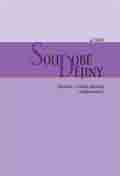Zlom mezi „totalitou“ a „demokracií“. Československý rok 1989 v alternativách
The Turning-point between ‘Totalitarianism’ and ‘Democracy’: Hypothetical Outcomes to Events in Czechoslovakia in 1989
Author(s): Jiří SukSubject(s): History
Published by: AV ČR - Akademie věd České republiky - Ústav pro soudobé dějiny
Summary/Abstract: The consideration of hypothetical alternatives to historical development in clearly established general conditions are, the author believes, a natural part of historical thinking. In this article he looks at the ‘Velvet Revolution’, that short period from the collapse of the Communist régime to the pushing through of a democracy in Czechoslovakia in November and December 1989, which for him becomes the space for such hypothetical reflections. In the historical records he seeks the key junctures in developments, and tries to outline the directions or paths that the political actors and members of the public could have set out on, but did not. In each case he starts from the assumption that one important factor of the previous events has changed. First of all, he asks whether a possibility of fundamental change had begun to emerge even before 17 November 1989, and he seeks to answer the question with regard to the infl uence of Gorbachev’s perestroika. He calls the Reform Communists, who had been expelled from the Party, the legitimate potential Czechoslovak actors of perestroika. These Communists were based around the Klub pro socialistickou přestavbu Obroda (Renewal, the Club for Socialist Restructuring), and sought to continue the ideals of the ‘Prague Spring’ of 1968. Like every other potential opposition group, however, they were kept down by the ‘normalization’ régime. In circumstances in which the Soviet Union, of its own accord, was ceasing to intervene directly in the affairs of the other Soviet bloc states (which in Czechoslovakia meant the petrifi cation of the ‘conservative’ structures of power), the reformists’ chances were, the author argues, very limited. He then considers the fundamental interpretations, which emerged in the 1990s, of the Velvet Revolution as a conspiracy. The core of the article is a consideration of the probability, the concrete forms, and possible consequences of six possible outcomes of developments: (i) after the brutal police action against the demonstrators on Národní třída, Prague, on 17 November 1989, the would not have led to the spreading of the false report about the killing of a student named Martin Šmíd which mobilized the Czechoslovak public; (ii) the leadership of the Czechoslovak Communist Party would have tended to some kind of violent solution to the crisis with the help of the army on the ‘Chinese model’; (iii) in the revolutionary days the existing Communist leadership would have joined forces with the former reform Communists with the aim of preserving a Socialist régime; (iv) in December 1989 the Civic Forum would not have managed to get the Federal Assembly to elect Václav Havel President of Czechoslovakia, and in the following months the president would have been elected by popular vote from amongst several candidates, as had been proposed by the Communist Party;
Journal: Soudobé Dějiny
- Issue Year: XVI/2009
- Issue No: 04
- Page Range: 557-601
- Page Count: 45
- Language: Czech

